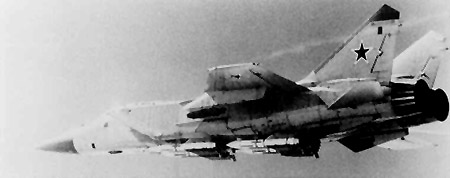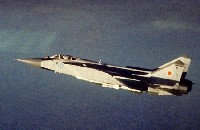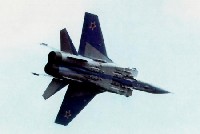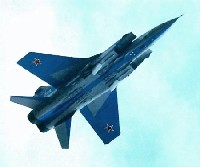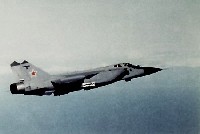Global Aircraft -- MiG-31 Foxhound
|
Aviation Center
US Attack
US Bombers
US Cargo
US Fighters
US Helicopters
US Patrol/Pursuit
US Reconnaissance
US Tankers
US Trainers
US UAV's
US X Planes
Orbiter Vehicles
WWI Aircraft
WWII Aircraft
Airbus
Antonov
Boeing
Dassault
Ilyushin
Kamov
MiG
Mil
Saab
Sukhoi
Tupolev
Yakovlev
Joint/Rest of World
Entertainment Center
Members Center
New Technologies
Contact Us
Extra Navigation
GAC Engine
MiG-31 Foxhound Specifications
MiG-31 Foxhound Achievements
MiG-31 Foxhound Features
Like the MiG-25, the Foxhound is a large twin-engine aircraft with side-mounted air intakes, a shoulder-mounted wing with an aspect ratio of 2.94, and twin vertical tailfins. Unlike the Foxbat, it has two seats, with the rear occupied by a dedicated weapon systems officer.
The wings and airframe of the MiG-31 are stronger than those of the MiG-25, permitting supersonic flight at low altitudes. Its Aviadvigatel D30-F6 turbofans, rated at 34,000 pounds thrust, (also described as "bypass turbojets" due to the low bypass ratio) allow a maximum speed of Mach 1.23 at low altitude. High-altitude speed is temperature-redlined to Mach 2.83 %u2014 the thrust-to-drag ratio is sufficient for speeds in excess of Mach 3, but such speeds pose unacceptable hazards to engine and airframe life in routine use. Given the MiG-31's role as Mach 2.8 interceptor and the sustained afterburning this requires, its fuel consumption is higher when compared to other aircraft serving in different roles, such as the Su-27. As a result, the aircraft's fuel fraction has been increased to more than 0.40 %u2014 16,350 kg (36,050 lb) of high-density T-6 jet fuel. The outer wing pylons are also plumbed for drop tanks, allowing an extra 5,000 liters (1,320 gallons) of external fuel. Late-production aircraft have aerial refueling probes. Despite the stronger airframe, the Foxhound is limited to a maximum of 5 g at supersonic speeds. At combat weight, its wing loading is marginal and its thrust to weight ratio is favorable. However, it is not designed for close combat or rapid turning. The MiG-31 was the world's first operational fighter with a passive electronically scanned array radar, the Zaslon S-800. Its maximum range against fighter-sized targets is approximately 200 km (125 mi), and it can track up to 10 targets and simultaneously attack four of them with its AA-9 'Amos' missiles. It is claimed to have limited astern coverage (perhaps the reason for the radome-like protuberance above and between the engines). The radar is matched with an infrared search and tracking (IRST) system in a retractable undernose fairing. Up to four MiG-31s, spaced up to 200 km (125 mi) apart to cover a wide swath of territory, can coordinate via datalink. The MiG-31M-, MiG-31D-, and MiG-31BS-standard aircraft have an upgraded Zaslon-M passive electronically scanned phased array radar (PESA) with larger antenna and greater detection range (said to be 400 km (250 mi) against AWACS-size targets) and the ability to attack multiple targets -air and ground- simultaneously. The back-seater's controls are replaced with modern MFDs. Its electronic countermeasures capabilities have also been upgraded, with new ECM pods on the wingtips. The aircraft is a two-seater with the rear seat occupant controlling the radar. Although cockpit controls are duplicated across cockpits, it is normal for the aircraft to be flown only from the front seat. The pilot flies the aircraft by means of a centre stick and left hand throttles. The rear cockpit has only two small vision ports on the sides of the canopy. It is argued that the presence of the WSO (Weapon Systems Operator) in the rear cockpit improves aircraft effectiveness since he is entirely dedicated to radar operations and weapons deployment. This decreases the workload of the pilot and increases efficiency. Both cockpits are fitted with zero/zero ejection seats which allow the crew to eject at any altitude and airspeed. Some upgrade programmes have found their way to the MiG-31 fleet, for example the MiG-31BM multi-role version which includes upgraded avionics. In the cockpit this upgrade provides for the use of new weapons, a new multimode radar, HOTAS controls and liquid-crystal (LCD) colour multi-function displays (MFDs). Only a small part of the fleet, however, has been upgraded to this standard. It has been claimed by Russian Federation Defence Ministry chief Colonel Yuri Balyko, that the upgrade will increase the combat effectiveness of the aircraft several times over. The MiG-31's main armament is four R-33 air-to-air missiles (NATO codename AA-9 'Amos') carried under the belly. The R-33 is the Russian equivalent of the U.S. Navy's AIM-54 Phoenix. It can be guided in semi-active radar homing (SARH) mode, or launched in inertial guidance mode with the option of mid-course updates from the launch aircraft and switching to SARH for terminal guidance. A more advanced version of the weapon, the AA-X-13 'Arrow', which is the replacement for the older R-33, features folding stabilizers to reduce its stored size. Other weapons include the old AA-6 'Acrid', originally deployed on the MiG-25, and the AA-8 'Aphid' or AA-11 'Archer' short-range IR missiles, carried on wing pylons. Currently the entire MiG-31 fleet is being refitted to carry the newer AA-12 'Adder' on the wing pylons. Unlike the MiG-25, the MiG-31 has an internal cannon, a six-barrel, 23 mm GSh-6-23 with 800 rounds of ammunition, mounted above the starboard main landing gear bay. The GSh-6-23 has a claimed rate of fire of over 10,000 rounds per minute. A new version of the 'Foxhound' with upgraded avionics, the MiG-31B, was introduced in 1990. Its development was the result of the Soviet discovery that Phazotron radar division engineer Adolf Tolkachev had sold information on advanced radars to the West. Tolkachev was executed, and a new version of the compromised radar was hastily developed. Many earlier MiG-31s were upgraded to the new standard, designated MiG-31BS. Development of a more comprehensive advanced version, the MiG-31M, began in 1983 and first flew in 1986, but the collapse of the Soviet Union prevented it from entering full production. Since 1991 and especially since 2000, most of the existing aircraft have been upgraded to the MiG-31M standard, also adding some additional features like Global Positioning System (GPS) and GLONASS receivers, and three colour CRT MFDs in the rear cockpit.(In the VVS, aircraft designations are often repeated through the years; for example, the Su-35 'Flanker-E' and Su-37 'Flanker-F' are both designated "Su-27M".) It was the heaviest interceptor in the world, with a maximum takeoff weight on 56 tonnes. It was even heavier than a commercial Tu-134 which has a maximum takeoff weight of 49 tonnes. Several other variants have been developed, including a dedicated anti-satellite missile carrier, the MiG-31D; a similar satellite-launching aircraft, MiG-31A; a proposed multi-role version, MiG-31F; and a downgraded export version, MiG-31E; but most have not been built in any quantity, if at all.
MiG-31 Foxhound Background
LikYe-155MP prototype which first flew on 16 September 1975. Although it bore a superficial resemblance to a stretched MiG-25 (with a longer fuselage for the radar operator cockpit), it was in many respects a totally new design. Soviet manufacturing limitations forced the MiG-25 to use nickel steel for 80% of its structure. The Ye-155MP doubled the use of titanium to 16% and tripled the aluminum content to 33% to reduce structural mass. More importantly, supersonic speed was now possible at low-level altitudes. Fuel capacity was also increased, and new, more efficient low-bypass-ratio turbofan engines were fitted.
Like its MiG-25 predecessor, the MiG-31 was surrounded by early speculation and misinformation concerning its design and capabilities. The West learned of the new interceptor from Lieutenant Viktor Belenko, a pilot who defected to Japan in 1976 with his MiG-25P. Belenko described an upcoming "Super Foxbat" with two seats and a capability to intercept cruise missiles. According to his testimony, the new interceptor was to have air intakes similar to the MiG-23 'Flogger', which the MiG-31 in reality does not have, at least not in production variants. While undergoing testing, a MiG-31 was spotted by a reconnaissance satellite at the Zhukovsky flight test center near the town of Ramenskoye. The images were interpreted as a fixed-wing interceptor version of a swing-wing fighter codenamed the "Ram-K". The latter was eventually revealed to be the Sukhoi Su-27 'Flanker', a wholly unrelated design. | ||||||||||||||||||||||||||||||||||||||
